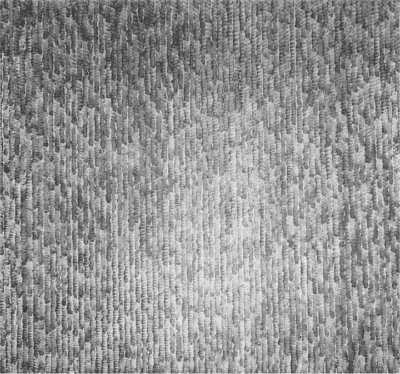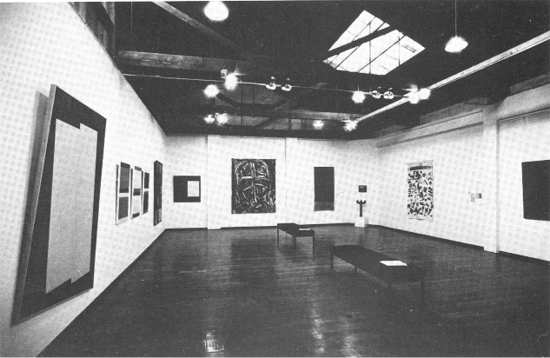Exhibitions Wellington
ELVA BETT
Robert McLeod: Paintings & Drawings 1972 to 1981
'Standing as it does outside the indigenous Regionalist school of art gives Robert McLeod's work a strength and added vitality . . .' Petar Vuletic, when opening this exhibition, in such words waxed hot against the indigenous regionalist school prevalent in New Zealand and upheld by art commentators. His lengthy diatribe held many criticisms of New Zealand painting today, most of which I fully endorsed.

ROBERT McLEOD
Emerald and Black Oil 1981
oil on canvas, 1700mm x 1830mm
McLeod's work is mature; it has vigour and timelessness. The five latest paintings, dated 1981, are elegant and more lineal than before. The range of subtle colours is more consciously worked for than with the spontaneous splatter paintings of 1979 / 80.
The exhibition provided a comprehensive survey of the development of an artist who will not allow an inconsequential drawing or painting to survive. Tracing McLeod's development from his Glaswegian beginnings and early influences gives new credence to his present attainment of a personal idiom. In New Zealand he has found the freedom from claustrophobia and economic depression to expand and develop his ideas. Those ideas are influenced not by myth or story-telling but by the exploitation of the possibilities of materials. 'How I paint is more important than what I paint' he states. (His straight-from-the-shoulder Scotsman's candour in answer to questions put to him by the Director is published in the catalogue along with a Petar Vuletic eulogy.)
Opening of The Janne Land Gallery
On April 26, a Sunday afternoon two Philip Clairmont-designed doors opened up the new Janne Land Gallery - a vast space of white walls, neutral flooring and high stud.
Allen Street is traditionally the fruit and market area of Wellington and the placing of an art complex right in its midst is an adventurous act.
The Gallery was officially launched with the ceremonial opening of the Clairmont diptych, Magic Theatre; and the exhibition within is representative of the amount of support forthcoming from a wide range of artists.

Interior view of the
Janne Land Gallery,
April 1981
The far wall is dominated by Clairmont's Cruciform Window for A, an oil on jute canvas; and a small Fomison, The Man of Peace and the Man of War (Te Whiti and Titokowara), oil on canvas, is set at right angles on a corner wall. Before it stands a three-candle candelabra by Russell Moses.
Also showing is Ralph Hotere's Sangro Litany, acrylic on canvas; a song/poem for a Tangi - esoteric white hieroglyphics on black (with thoughtful annotations); and a Gordon Crook tapestry created for the exhibition - a colourful floating geometry skilfully woven by Lesley Nicholls.
Backgrounding the inevitable conviviality of opening night was a brilliant orange and blue Don Driver, constructed in plastic and canvas collage, with the words Granular Carbons stencilled on the tangerine-painted nylon sacks. The artist's shock tactics are revealed in the accompanying assemblage, Rat: three plastic buckets topped by a sparsely-clad baby doll being molested by a toy mouse.
The hackneyed Day and Night, when applied to symbolic black and yellow discs within a painting, is disappointing, used by this year's Hodgkins Fellow, Gretchen Albrecht. But it was James Ross's large asymmetrical oil and wax on canvas, Dos Cuerpos, that provided the greatest surprise. It consisted of two overlapping dun-coloured rectangles within a navy/green ground. Vivian Lynn's oil and silk-screen, restrained in colour, was a new departure and very accomplished.
Complementing these larger works were other paintings that were worthy examples of each artist's style. There was John Parker's Celebration, oil on jute: a very earthy work; Stephen Bambury's Colour Stack triptych, acrylic on canvas; and Max Gimblett's Otherside.
